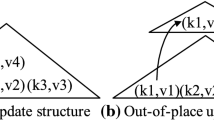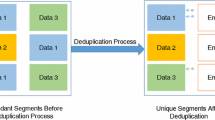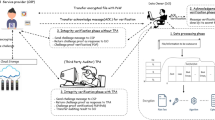Abstract
With the rapid development of computer network and the fever of office automation, data storage gains more and more attentions. In recent years, P2P system-one of data storage networks, has been studied widely because of its high performances (e.g. in terms of distributed and extensibility). One of data storage challenges in it is how to improve data survivability under churn, which is caused by nodes’ joining or leaving in the network. Increasing replicas is a comparatively good way to enhance the system fault tolerance, especially under high churn. According to existing references of the replication strategy which always focus on specific P2P systems, we propose a balanced replication method based on the zones partition-BRBZs which mainly consists of the copy distribution mechanism, the query mechanism and the consistency maintenance mechanism. It is a general way that BRBZs can be applied in different P2P networks. Meanwhile, we evaluate the performance of the BRBZs strategy by applying it in DHT systems with different routing protocols to compare with other replication strategies. Performance indexes are innovatively divided into dynamic and static indexes, making the evaluation of algorithm performance more comprehensive and accurate. Simulation results declare that the BRBZs has not only better data availability, higher query efficiency and lower searching fail-rate, but good scalability to be applied in systems with different sizes. Besides, the system applying BRBZs is convenient for management and maintenance as its user access interface bases on different protocols without centralized servers.














Similar content being viewed by others
References
Karafiloski E, Mishev A (2017) Blockchain solutions for big data challenges: a literature review. Int Conf Smart Technol. https://doi.org/10.1109/EUROCON.2017.8011213
Chen K, Shen H, Sapra K (2016) A social network based reputation system for cooperative P2P file sharing. IEEE Trans Parallel Distrib Syst 26(8):2140–2153
Waluyo AB, Taniar D, Rahayu W (2017) Trustworthy data delivery in Mobile P2P network. J Comput Syst Sci 86:33–48
Park SH, Park JK (2016) IoT industry and security technology trends. Int J Adv Smart Converg 5(3):27–31
Raj P, Raman A, Nagaraj D, Duggirala S (2015) High-performance peer-to-peer systems. In: High-performance big-data analytics. Computer communications and networks, 317–337. Springer, Cham
Masseglia F, Poncelet P, Teisseire M (2006) Peer-to-peer usage analysis: a distributed mining approach. Int Conf Adv Inf Netw Appl. https://doi.org/10.1109/AINA.2006.262
Yahya HN, Alptekin K, Öznur Ö (2018) Decentralized and locality aware replication method for DHT-based P2P storage systems. Futur Gener Comput Syst 84:32–46
Spaho E, Barolli A, Xhafa F, Barolli L (2015) P2P data replication: techniques and applications. In: Xhafa F, Barolli L, Barolli A, Papajorgji P (eds) Modeling and processing for next-generation big-data technologies, 145–166. Springer, Cham
Arnedo J, Matsuo K, Barolli L, Xhafa F (2011) Secure communication setup for a P2P based JXTA-overlay platform. IEEE Trans Ind Electron 58(6):2086–2096
Barolli L, Xhafa F (2011) JXTA-overlay: a P2P platform for distributed, collaborative, and ubiquitous computing. IEEE Trans Ind Electron 58(6):2163–2172
Enokido T, Aikebaier A, Takizawa M (2011) Process allocation algorithms for saving power consumption in peer-to-peer systems. IEEE Trans Ind Electron 58(6):2097–2105
Waluyo AB, Rahayu W, Taniar D, Scrinivasan B (2011) A novel structure and access mechanism for Mobile data broadcast in digital ecosystems. IEEE Trans Ind Electron 58(6):2173–2182
Ratnasamy S, Francis P, Handley M, Karp R, Shenker S (2001) A scalable content -addressable network. Conference on applications, technologies, architectures and protocols for computer communications. 31, 161–172
Rowstron A, Druschel P (2001) Pastry: scalable, decentralized object location, and routing for large-scale peer-to-peer systems. In: Guerraoui R (ed) Middleware, 329–350. Springer, Heidelberg
Stoica I, Morris R, Karger D, Kaashoek MF, Balakrishnan H (2001) Chord: a scalable peer-to-peer lookup service for internet applications. Conference on Applications, Technologies, Architectures and Protocols for Computer Communications 31, 149–160
Malik SUR, Khan SU, Ewen SJ, Tziritas N, Kolodziej J, Zomaya AY, Madani SA, Min-Allah N, Wang L, Xu CZ, Malluhi QM, Pecero JE, Balaji P, Vishnu A, Ranjan R, Zeadally S, Li H (2016) Performance analysis of data intensive cloud systems based on data management and replication: a survey. Distrib Parallel Databases 34(2):179–215
Liu GX, Shen HY, Chandler H (2016) Selective data replication for online social networks with distributed datacenters. IEEE Trans Parallel Distrib Syst 27(8):2377–2393
Matri P, Pérez MS, Costan A, Bougé L, Antoniu G (2017) Keeping up with storage: decentralized, write-enabled dynamic geo-replication. Futur Gener Comput Syst 86:1093–1105
Paiva J, Rodrigues L (2015) On data placement in distributed systems. ACM SIGOPS Oper Syst Rev 49(1):126–130
Varga A (2010) OMNeT++. In: Wehrle K, Güneş M, Gross J (eds) Modeling and tools for network simulation. Springer, Heidelberg
Abraham I, Awerbuch B, Azar Y, Bartal Y, Malkhi D, Pavlov E.: A generic scheme for building overlay networks in adversarial scenarios. In: Parallel and distributed processing symposium. 9, 40b
Medrano-Chávez AG, Pérez-Cortés E, Lopez-Guerrero M (2015) A performance comparison of chord and Kademlia DHTs in high churn scenarios. Peer-to-Peer Netw Appl 8:807–821
Kuhn F, Schmid S, Wattenhofer R (2005) A self-repairing peer-to-peer system resilient to dynamic adversarial churn. In: Castro, M., van Renesse, R. (eds). Peer-to-Peer Syst 3640:13–23
Guidi B, Amft T, De Salve A et al (2016) DiDuSoNet: a P2P architecture for distributed Dunbar-based social networks. Peer-to-Peer Netw Appl 9(6):1177–1194
Li S, Lan T, Ra MR (2016) Background traffic optimization for meeting deadlines in data center storage. Proceedings of the conference on information science and systems, 372–377. Princeton, America
Lam S, Liu H (2006) Failure recovery for structured P2P networks: protocol design and performance evaluation. Commun Netw 50(16):3083–3104
Liu Z, Yuan R, Li Z, Li H, Chen G (2006) Survive under high churn in structured P2P systems: evaluation and strategy. In: Alexandrov, V.N., van Albada, G.D., Sloot, P.M.A., Dongarra J. (eds). Comput Sci 3994:404–411
Silva T, Kamienski C, Fernandes S, Sadok D (2015) A flexible DHT based directory service for information management. Peer-to-Peer Netw Appl 8:512–531
Ohmata H, Ishikawa K, Sakakihara H et al. (2011) Churn-resistant method for DHT-based content delivery systems. IEEE Consumer Commun Netw Conf. https://doi.org/10.1109/CCNC.2011.5766536
Rahmani M (2014) A comparative study of replication schemes for structured P2P networks. ResearchGate.https://www.researchgate.net/publication/264419857_A_Comparative_Study_of_Replication_Schemes_for_Structured_P2P_Networks. Accessed 4 Dec 2017
Jin X, Li D, Yu X et al (2010) Design of Distributed Secure Storage System Based on random matrix and chord. International conference on computer, mechatronics, control and. Electron Eng 6:402–405
Rowstron A, Druschel P (2001) Pastry: scalable, decentralized object location, and routing for large-scale peer-to-peer systems. Middleware. 2218:329–350
Dabek F, Li J, Sit E et al (2004) Designing a DHT for low latency and high throughput. Proc Nsdi 1:85–98
Zhou SY, Wang K, Zhang YF et al (2011) Generalized Minimum Information Path Routing Strategy on Scale-Free Networks. Chin Phys B 20(8):501–505
Zhao BY, Huang L, Stribling J, Rhea SC, Joseph AD, Kubiatowicz JD (2004) Tapestry: a resilient global-scale overlay for service deployment. IEEE J Sel Areas Commun 22(1):41–53
Li Z, Xie G, Kai H et al (2011) Churn-resilient protocol for massive data dissemination in P2P networks. IEEE Trans Parallel Distrib Syst 22(8):1342–1349
Ghodsi A, Alima LO, Haridi S (2006) Symmetric replication for structured peer-to-peer systems. Databases Inf Syst Peer-to-Peer Comput 4125:74–85
Mohammad AK, Hillol D, Cristian B (2016) Balanced content replication in peer-to-peer online social networks. Proceedings of the IEEE international conferences on big data and cloud computing, 274–283. Atlanta, America
Huang CQ, Li Y, Wu HY (2014) Modeling and maintaining the reliability of data replica service in cloud storage systems. J Commun 35(10):89–97
Kermarrec AM, Merrer EL, Straub G et al (2012) Availability-based methods for distributed storage systems. Reliable Distrib Syst 42(1):151–160
Nakashima T, Fujita S (2015) Scalable Tree-Based Consistency Maintenance in Heterogeneous P2P File Sharing Systems. Proceedings of the 44th International Conference on Parallel Processing Workshops, 250–256. Beijing, China
Loo B, et al. (2005) The case for a hybrid P2P Search Infrastructure. In: Voelker, G., Shenker, S. (eds) Peer-to-Peer Systems III. Springer, 141–150
Akbari TJ (2012) A distributed resource discovery algorithm for P2P grids. J Netw Appl 35(6):2028–2036
Flocchini P, Nayak A, Xie M (2005) Hybrid-chord: a peer-to-peer system based on chord. In: Ghosh, R.K., Mohanty, H. (eds) Distributed computing and internet technology. 194–203
Acknowledgements
We would like to thank the two anonymous reviewers for their insightful comments and suggestions, which have helped to improve the quality of our paper. This work is supported by the National Natural Science Foundation of China (Grants No. 61877067, 61572435), Joint fund project the Ministry of Education - the China Mobile (No. MCM20170103), Xi’an Science and Technology Innovation Project (Grants No.201805029YD7CG13-6), Ningbo Natural Science Foundation (Grants No. 2016A610035, 2017A610119).
Author information
Authors and Affiliations
Corresponding author
Additional information
Publisher’s note
Springer Nature remains neutral with regard to jurisdictional claims in published maps and institutional affiliations.
Rights and permissions
About this article
Cite this article
Qi, X., Qiang, M. & Liu, L. A balanced strategy to improve data invulnerability in structured P2P system. Peer-to-Peer Netw. Appl. 13, 368–387 (2020). https://doi.org/10.1007/s12083-019-00773-9
Received:
Accepted:
Published:
Issue Date:
DOI: https://doi.org/10.1007/s12083-019-00773-9




